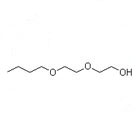What is Butyl Di Glycol?
Butyl di glycol (also known as BDG, butyl dioxitol, diethylene glycol monobutyl ether, 2(-2butoxyethoxy) ethanol and butoxydiethylene glycol) is a colourless, clear organic compound with a faint characteristic odour that has the formula C8H18O3. It is soluble in water and miscible with many common solvents, and also has low volatility and a high boiling point. These are the factors that make butyl di glycol most useful in the paint industry.

How is it produced?
Butyl di glycol is one of the co-products formed when ethylene molecules are reacted with n-butanol using an alkali catalyst. If the ratio of ethylene to butanol is higher than two at the end of this process, then butyl diglycol is produced (along with tri-ethylene glycol monoethers).
How is it stored and distributed?
Butyl di glycol is stored and transported either in bulk isocontainers or in drums made of mild steel and/or stainless steel and should always be stored under nitrogen. The room temperature where it is stored should not reach over 40 °C as it can oxidise at higher temperatures.
Butyl di glycol is not classified as dangerous for any form of transport but is classified as an irritant and should not be in contact with strong acids or oxidisers. It has a flashpoint of 105 °C (closed cup) and a specific gravity of 0.955. Keeping butyl diglycol in the appropriate conditions can give it a shelf life of up to a year.
What is Butyl Di Glycol used for?
Butyl di glycol is most commonly used in the coatings and paint industries where its low volatility and high boiling point have seen it widely accepted as a flow promoter for baking finishes such as melamine, urea, phenol, or epoxy resin composites. It is also widely used in stove enamels as it has a high evaporation number which means that the enamel properties can be improved without it affecting the drying time. It also has a role in air-drying paints as it increases “brushability”.
Butyl di glycol is also found in the printing industry where it is a solvent for printing inks, and is also a starting material in the production of butyl diglycol acetate.



